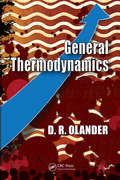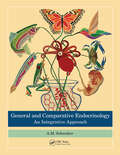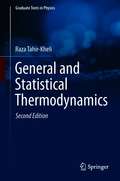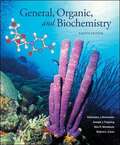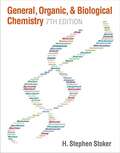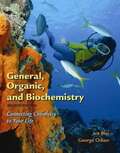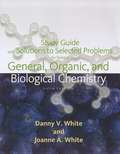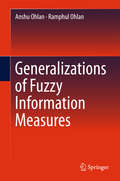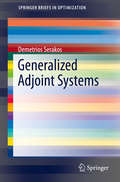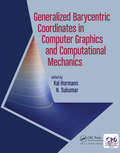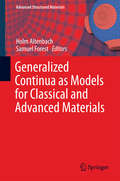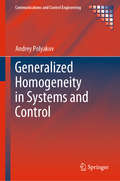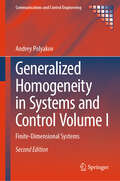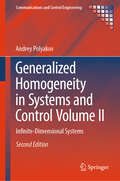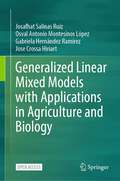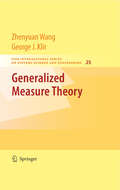- Table View
- List View
General Thermodynamics
by Donald OlanderBecause classical thermodynamics evolved into many branches of science and engineering, most undergraduate courses on the subject are taught from the perspective of each area of specialization. General Thermodynamics combines elements from mechanical and chemical engineering, chemistry (including electrochemistry), materials science, and biology to present a unique and thorough treatment of thermodynamics that is broader in scope than other fundamental texts.This book contains classroom-tested materials designed to meet the academic requirements for students from a variety of scientific and engineering backgrounds in a single course. The first half focuses on classical concepts of thermodynamics, whereas the latter half explores field-specific applications, including a unique chapter on biothermodynamics. The book’s methodology is unified, concise, and multidisciplinary, allowing students to understand how the principles of thermodynamics apply to all technical fields that touch upon this most fundamental of scientific theories. It also offers a rigorous approach to the quantitative aspects of thermodynamics, accompanied by clear explanations to help students transition smoothly from the physical concepts to their mathematical representations. Each chapter contains numerous worked examples taken from different engineering applications, illustrations, and an extensive set of exercises to support the material. A complete solutions manual is available to professors with qualifying course adoptions.
General and Comparative Endocrinology: An Integrative Approach
by A.M. SchreiberGeneral and Comparative Endocrinology: An Integrative Approach, takes a holistic approach to endocrinology, introducing students to the diverse facets of this interdisciplinary science ranging from the medical to comparative domains, while also exploring evolutionary, environmental, and conservation specializations within the field. The textbook is founded on the principle that students interested in the health sciences will benefit from understanding how proficiency in endocrine function among a diversity of organisms contributes to advances in modern medicine. Likewise, students intrigued by comparative physiology will benefit from the wealth of knowledge derived from medical/clinical endocrinology, the historical bedrock of the field. This textbook represents the modern field of endocrinology in its totality by addressing topics and recent advances not currently discussed in other introductory endocrinology textbooks. Key Features Introduces the broad and interdisciplinary scope of endocrinology. Provides clear chapter objectives and key concepts. Includes summary and synthesis questions for each chapter that are suitable for exams and quizzes. Includes a chapter devoted to endocrine-disrupting chemicals. Describes the roles played by the endocrine system in important health challenges related to appetite regulation, obesity, diabetes, and other diseases stemming from ‘mismatches to modernity’. Integrates evolutionary and comparative approaches to hormones and health.
General and Molecular Pharmacology
by Francesco Clementi Guido FumagalliWith a focus on functional relationships between drugs and their targets, this book covers basic and general pharmacology, from a cellular and molecular perspective, with particular attention to the mechanisms of drug action - the fundamental basis for proper clinical use- without neglecting clinical application, toxicology and pharmacokinetics. * Covers cell and molecular pharmacology, bringing together current research on regulation of drug targets, at a level appropriate for advanced undergrad and graduate students * Discusses the relevance of pharmacokinetics and drug development for the clinical application of drugs * Presents material from the perspective of drug targets and interaction, the theoretical basis of drug action analysis, and drug properties * Focuses on structure-function relationships of drug targets - informing about their biochemical and physiologic functions and experimental and clinical pathways for drug discovery and development * Has a companion website that offers a host of resources: short additional chapters about methodology, topics at the forefront of research, all figures and tables from the book, and Power Point slides
General and Statistical Thermodynamics (Graduate Texts in Physics)
by Raza Tahir-KheliThis textbook provides comprehensive information on general and statistical thermodynamics. It begins with an introductory statistical mechanics course, deriving all the important formulae meticulously and explicitly, without mathematical shortcuts. In turn, the main part of the book focuses on in-depth discussions of the concepts and laws of thermodynamics, van der Waals, Kelvin and Claudius theories, ideal and real gases, thermodynamic potentials, phonons and all related aspects. To elucidate the concepts introduced and to provide practical problem-solving support, numerous carefully worked-out examples are included. The text is clearly written and punctuated with a number of interesting anecdotes. The book also provides alternative solutions to problems and second equivalent explanations of important physical concepts. This second edition has been expanded to cover the foundations of superconductivity with new chapters on Cooper pairs, the Bogoliubov transformation, and superconductivity. It is suitable as a main thermodynamics textbook for upper-undergraduate students and provides extensive coverage, allowing instructors to ‘pick and choose’ the elements that best match their class profile.
General, Organic And Biochemistry
by Katherine J. Denniston Joseph J. Topping Kim R. Woodrum Robert L. CaretThe eighth edition of General, Organic, and Biochemistry is designed to help undergraduate health-related majors, and students of all other majors, understand key concepts and appreciate the significant connections between chemistry, health, disease, and the treatment of disease. This text continues to strike a balance between theoretical and practical chemistry, while emphasizing material that is unique to health-related studies. The text has been written at a level intended for students whose professional goals do not include a mastery of chemistry, but for whom an understanding of the principles and practice of chemistry is a necessity. Designed for the one- or two-semester course, this text has an easy-to-follow problem-solving pedagogy, vivid illustrations, and engaging applications.
General, Organic, And Biochemistry: An Applied Approach
by James ArmstrongFocusing on key topics important in allied health and nursing careers, this engaging book is ideal for readers who have had no prior exposure to chemistry. Emphasizing problem-solving techniques, the book takes the most direct path to biomolecules and metabolic processes, provides a wealth of worked examples to help readers understand key chemical concepts, includes novel and relevant "Health Notes" in the margins, and weaves biological and medical applications throughout.
General, Organic, And Biological Chemistry
by H. Stephen StokerSucceed in chemistry with GENERAL, ORGANIC, AND BIOLOGICAL CHEMISTRY'S clear explanations, engaging visual support, and easy usability. Ideal for allied health majors, this Seventh Edition emphasizes the applications of chemistry. Early chapters focus on fundamental chemical principles while later chapters build on the foundation of these principles, developing the concepts and applications central to organic and biological chemistry. Mathematics is introduced at point-of-use and only as needed.
General, Organic, And Biological Chemistry
by Karen C. Timberlake Laura D. Frost S. Todd DealFrost and Deal's General, Organic, and Biological Chemistry gives students a focused introduction to the fundamental and relevant connections between chemistry and life. Emphasizing the development of problem-solving skills with distinct Inquiry Questions and Activities, this text empowers students to solve problems in different and applied contexts relating to health and biochemistry. Integrated coverage of biochemical applications throughout keeps students interested in the material and allow for a more efficient progression through the topics. Concise, practical, and integrated, Frost's streamlined approach offers students a clear path through the content. Applications throughout the narrative, the visual program, and problem-solving support in each chapter improve their retention of the concepts and skills as they master them. General, organic, and biological chemistry topics are integrated throughout each chapter to create a seamless framework that immediately relates chemistry to students' future allied health careers and their everyday lives.
General, Organic, and Biochemistry
by McGraw-Hill CreateGeneral, Organic, and Biochemistry Custom Edition
General, Organic, and Biochemistry: Connecting Chemistry to Your Life
by George Odian Ira BleiGeneral, Organic and Biochemistry is praised for the way it gives students the tools they need to develop a working understanding of chemical principles—rather than just asking them to memorize facts. The new edition brings forward the same clear explanations, quality problem-solving support, helpful pedagogy, and applications coverage, adding new features and content to make the text even more accessible, effective, and relevant to its student audience.
General, Organic, and Biological Chemistry: Structures of Life
by Karen TimberlakeGeneral, Organic, and Biological Chemistry: Structures of Life engages students by helping them see the connections between chemistry, the world around them, and future health-related careers. Known for its friendly writing style, student focus, robust problem-solving pedagogy, and engaging health-related applications, the text prepares students for their careers. The text breaks chemical concepts and problem solving into clear, manageable pieces to ensure students stay on track and motivated throughout their first, and often only, chemistry course. <p><p> With the newly revised 6th Edition, best-selling author Karen Timberlake and new contributing author MaryKay Orgill connect chemistry to real-world and career applications. Their goal is to help students become critical thinkers by understanding scientific concepts that will form a basis for making important decisions about issues concerning health and the environment and their intended careers. <p> The new edition introduces more problem-solving strategies, more problem-solving guides, new Analyze the Problem with Connect features, new Try It First and Engage features, conceptual and challenge problems, and new sets of combined problems—all to help students develop the problem-solving skills they’ll need beyond the classroom.
General, Organic, and Biological Chemistry: Study Guide with Solutions to Selected Problems (5th Edition)
by H. Stephen StokerThe purpose of this study guide is to help students in the study of the textbook, General, Organic, and Biological Chemistry, by H. Stephen Stoker, by providing summaries of the text and additional practice exercises.
Generalizations of Fuzzy Information Measures
by Anshu Ohlan Ramphul OhlanThis book develops applications of novel generalizations of fuzzy information measures in the field of pattern recognition, medical diagnosis, multi-criteria and multi-attribute decision making and suitability in linguistic variables. The focus of this presentation lies on introducing consistently strong and efficient generalizations of information and information-theoretic divergence measures in fuzzy and intuitionistic fuzzy environment covering different practical examples. The target audience comprises primarily researchers and practitioners in the involved fields but the book may also be beneficial for graduate students.
Generalized Adjoint Systems
by Demetrios SerakosThis book defines and develops the generalized adjoint of an input-output system. It is the result of a theoretical development and examination of the generalized adjoint concept and the conditions under which systems analysis using adjoints is valid. Results developed in this book are useful aids for the analysis and modeling of physical systems, including the development of guidance and control algorithms and in developing simulations. The generalized adjoint system is defined and is patterned similarly to adjoints of bounded linear transformations. Next the elementary properties of the generalized adjoint system are derived. For a space of input-output systems, a generalized adjoint map from this space of systems to the space of generalized adjoints is defined. Then properties of the generalized adjoint map are derived. Afterward the author demonstrates that the inverse of an input-output system may be represented in terms of the generalized adjoint. The use of generalized adjoints to determine bounds for undesired inputs such as noise and disturbance to an input-output system is presented and methods which parallel adjoints in linear systems theory are utilized. Finally, an illustrative example is presented which utilizes an integral operator representation for the system mapping.
Generalized Barycentric Coordinates in Computer Graphics and Computational Mechanics
by N. Sukumar Kai HormannIn Generalized Barycentric Coordinates in Computer Graphics and Computational Mechanics, eminent computer graphics and computational mechanics researchers provide a state-of-the-art overview of generalized barycentric coordinates. Commonly used in cutting-edge applications such as mesh parametrization, image warping, mesh deformation, and finite as well as boundary element methods, the theory of barycentric coordinates is also fundamental for use in animation and in simulating the deformation of solid continua. Generalized Barycentric Coordinates is divided into three sections, with five chapters each, covering the theoretical background, as well as their use in computer graphics and computational mechanics. A vivid 16-page insert helps illustrating the stunning applications of this fascinating research area. <P><P>Key Features: <li>Provides an overview of the many different types of barycentric coordinates and their properties. <li>Discusses diverse applications of barycentric coordinates in computer graphics and computational mechanics. <li>The first book-length treatment on this topic
Generalized Continua as Models for Classical and Advanced Materials
by Holm Altenbach Samuel ForestThis volume is devoted to an actual topic which is the focus world-wide of various research groups. It contains contributions describing the material behavior on different scales, new existence and uniqueness theorems, the formulation of constitutive equations for advanced materials. The main emphasis of the contributions is directed on the following items - Modelling and simulation of natural and artificial materials with significant microstructure, - Generalized continua as a result of multi-scale models, - Multi-field actions on materials resulting in generalized material models, - Theories including higher gradients, and - Comparison with discrete modelling approaches
Generalized Continua as Models for Materials
by Holm Altenbach Anton Krivtsov Samuel ForestThis volume presents contributions describing the micro- and macro-behaviours, new existence and uniqueness theorems, the formulation of multi-scale problems, etc. and now it is time to ponder again the state of matter and to discuss new trends and applications. The main focus is directed on the following items - Modelling and simulation of materials with significant microstructure, - Generalized continua as a result of multi-scale models, - Multi-field actions on materials resulting in generalized material models, and - Comparison with discrete modelling approaches
Generalized Dynamics of Soft-Matter Quasicrystals: Mathematical Models, Solutions and Applications (Springer Series in Materials Science #260)
by Tian-You Fan Wenge Yang Hui Cheng Xiao-Hong SunThis book highlights the mathematical models and solutions of the generalized dynamics of soft-matter quasicrystals (SMQ) and introduces possible applications of the theory and methods. Based on the theory of quasiperiodic symmetry and symmetry breaking, the book treats the dynamics of individual quasicrystal systems by reducing them to nonlinear partial differential equations and then provides methods for solving the initial-boundary value problems in these equations. The solutions obtained demonstrate the distribution, deformation and motion of SMQ and determine the stress, velocity and displacement fields. The interactions between phonons, phasons and fluid phonons are discussed in some fundamental materials samples. The reader benefits from a detailed comparison of the mathematical solutions for both solid and soft-matter quasicrystals, gaining a deeper understanding of the universal properties of SMQ. The second edition covers the latest research progress on quasicrystals in topics such as thermodynamic stability, three-dimensional problems and solutions, rupture theory, and the photonic band-gap and its applications. These novel chapters make the book an even more useful and comprehensive reference guide for researchers in condensed matter physics, chemistry and materials sciences.
Generalized Homogeneity in Systems and Control (Communications and Control Engineering)
by Andrey PolyakovThis monograph introduces the theory of generalized homogeneous systems governed by differential equations in both Euclidean (finite-dimensional) and Banach/Hilbert (infinite-dimensional) spaces. It develops methods of stability and robustness analysis, control design, state estimation and discretization of homogeneous control systems. Generalized Homogeneity in Systems and Control is structured in two parts. Part I discusses various models of control systems and related tools for their analysis, including Lyapunov functions. Part II deals with the analysis and design of homogeneous control systems. Some of the key features of the text include: mathematical models of dynamical systems in finite-dimensional and infinite-dimensional spaces; the theory of linear dilations in Banach spaces;homogeneous control and estimation;simple methods for an "upgrade" of existing linear control laws; numerical schemes for a consistent digital implementation of homogeneous algorithms; and experiments confirming an improvement of PID controllers. The advanced mathematical material will be of interest to researchers, mathematicians working in control theory and mathematically oriented control engineers.
Generalized Homogeneity in Systems and Control Volume I: Finite-Dimensional Systems (Communications and Control Engineering)
by Andrey PolyakovThis book is an introduction to the theory of homogeneous systems, useful for the simplification of many types of nonlinear control problems. It propounds methods that can be employed when linearization proves unsuitable and provides a unified approach to stability and robustness analysis, control and observer design, and system discretization. The second edition splits the coverage of homogeneity, allowing expanded coverage of finite-dimensional systems (in this book) and infinite-dimensional systems (in Volume II). The results are better systematized and easier for readers to study and assimilate. The first volume details the concepts of finite-time and fixed-time stability. Key features of the book include: mathematical models of dynamical systems in finite-dimensional spaces; the theory of linear dilations in Euclidean spaces; homogeneous control and estimation; extensively expanded and original chapters with entirely new treatments of digitization, safety-critical systems, neural networks, and multiagent control; simple methods for an upgrade of existing linear control laws; numerical schemes for a consistent digital implementation of homogeneous algorithms; and experimental results that confirm an improvement of PID controllers. Illustrative examples—numerical results, computer simulations, and real experiments—support all the theoretical material. The coverage of finite-dimensional systems presented in this book is of interest to graduate students of control theory from engineering and applied-mathematical backgrounds and to practising control engineers.
Generalized Homogeneity in Systems and Control Volume II: Infinite-Dimensional Systems (Communications and Control Engineering)
by Andrey PolyakovThe second edition of Generalized Homogeneity in Systems and Control is an introduction to the theory of homogeneous systems, useful for the simplification of many types of nonlinear control problem. It propounds methods that can be employed when linearization proves unsuitable and provides a unified approach to stability and robustness analysis, control and observer design, and system discretization. The second edition splits the coverage of homogeneity, allowing expanded coverage of finite-dimensional systems (in Volume I) and infinite-dimensional systems (in this book). The results are better systematized and easier for readers to study and assimilate. Generalized Homogeneity in Systems and Control Volume II (second edition) moves from stability analysis to the design of controllers for various systems. Key features of the book include: mathematical models of dynamical systems in infinite-dimensional spaces; the theory of linear dilations in Banach and Hilbert spaces (including Lebesgue and Sobolev spaces); abstract differential equations with homogeneous operators (including differential operators); rewritten, reorganized chapters with the addition of substantial new material; robustness analysis of infinite-dimensional homogeneous systems; homogeneous control in a Hilbert space; and consistent discretization of homogeneous systems. Illustrative examples – numerical results, computer simulations and real experiments – support all the theoretical material. The coverage of infinite-dimensional systems presented in this book will be of interest to graduate students of control theory and applied mathematics and academic researchers in control.
Generalized Linear Mixed Models with Applications in Agriculture and Biology
by Osval Antonio Montesinos López Josafhat Salinas Ruíz Gabriela Hernández Ramírez Jose Crossa HiriartThis open access book offers an introduction to mixed generalized linear models with applications to the biological sciences, basically approached from an applications perspective, without neglecting the rigor of the theory. For this reason, the theory that supports each of the studied methods is addressed and later - through examples - its application is illustrated. In addition, some of the assumptions and shortcomings of linear statistical models in general are also discussed. An alternative to analyse non-normal distributed response variables is the use of generalized linear models (GLM) to describe the response data with an exponential family distribution that perfectly fits the real response. Extending this idea to models with random effects allows the use of Generalized Linear Mixed Models (GLMMs). The use of these complex models was not computationally feasible until the recent past, when computational advances and improvements to statistical analysis programs allowed users to easily, quickly, and accurately apply GLMM to data sets. GLMMs have attracted considerable attention in recent years. The word "Generalized" refers to non-normal distributions for the response variable and the word "Mixed" refers to random effects, in addition to the fixed effects typical of analysis of variance (or regression). With the development of modern statistical packages such as Statistical Analysis System (SAS), R, ASReml, among others, a wide variety of statistical analyzes are available to a wider audience. However, to be able to handle and master more sophisticated models requires proper training and great responsibility on the part of the practitioner to understand how these advanced tools work. GMLM is an analysis methodology used in agriculture and biology that can accommodate complex correlation structures and types of response variables.
Generalized Measure Theory
by Zhenyuan Wang George J. KlirGeneralized Measure Theory examines the relatively new mathematical area of generalized measure theory. The exposition unfolds systematically, beginning with preliminaries and new concepts, followed by a detailed treatment of important new results regarding various types of nonadditive measures and the associated integration theory. The latter involves several types of integrals: Sugeno integrals, Choquet integrals, pan-integrals, and lower and upper integrals. All of the topics are motivated by numerous examples, culminating in a final chapter on applications of generalized measure theory. Some key features of the book include: many exercises at the end of each chapter along with relevant historical and bibliographical notes, an extensive bibliography, and name and subject indices. The work is suitable for a classroom setting at the graduate level in courses or seminars in applied mathematics, computer science, engineering, and some areas of science. A sound background in mathematical analysis is required. Since the book contains many original results by the authors, it will also appeal to researchers working in the emerging area of generalized measure theory.
Generalized Notions of Continued Fractions: Ergodicity and Number Theoretic Applications (Chapman & Hall/CRC Monographs and Research Notes in Mathematics)
by Wolfgang Trutschnig Juan Fernández Sánchez Jerónimo López-Salazar Codes Juan B. Seoane SepúlvedaAncient times witnessed the origins of the theory of continued fractions. Throughout time, mathematical geniuses such as Euclid, Aryabhata, Fibonacci, Bombelli, Wallis, Huygens, or Euler have made significant contributions to the development of this famous theory, and it continues to evolve today, especially as a means of linking different areas of mathematics.This book, whose primary audience is graduate students and senior researchers, is motivated by the fascinating interrelations between ergodic theory and number theory (as established since the 1950s). It examines several generalizations and extensions of classical continued fractions, including generalized Lehner, simple, and Hirzebruch-Jung continued fractions. After deriving invariant ergodic measures for each of the underlying transformations on [0,1] it is shown that any of the famous formulas, going back to Khintchine and Levy, carry over to more general settings. Complementing these results, the entropy of the transformations is calculated and the natural extensions of the dynamical systems to [0,1]2 are analyzed. Features Suitable for graduate students and senior researchers Written by international senior experts in number theory Contains the basic background, including some elementary results, that the reader may need to know before hand, making it a self-contained volume
Generalized Perturbations in Modified Gravity and Dark Energy
by Jonathan PearsonWhen predictions of Einstein's theory of General Relativity are compared against observations of our Universe, a huge inconsistency is found. The most popular fix for this inconsistency is to "invent" around 94% of the content of the universe: dark matter and dark energy. The dark energy is some exotic substance responsible for the apparent observed acceleration of the Universe. Another fix is to modify the theory of gravity: it is entirely plausible that Einstein's theory of General Relativity breaks down on cosmological scales, just as Newton's theory of gravity breaks down in the extreme gravitational field of the Sun. There are many alternative theories of gravity, each with the aim of describing observations of our Universe where General Relativity fails. Whether it is dark energy or some modified theory of gravity, it is clear that there is some "dark sector" in the Universe. In this thesis the author constructs a unifying framework for understanding the observational impact of general classes of dark sector theories, by formulating equations of state for the dark sector perturbations.
